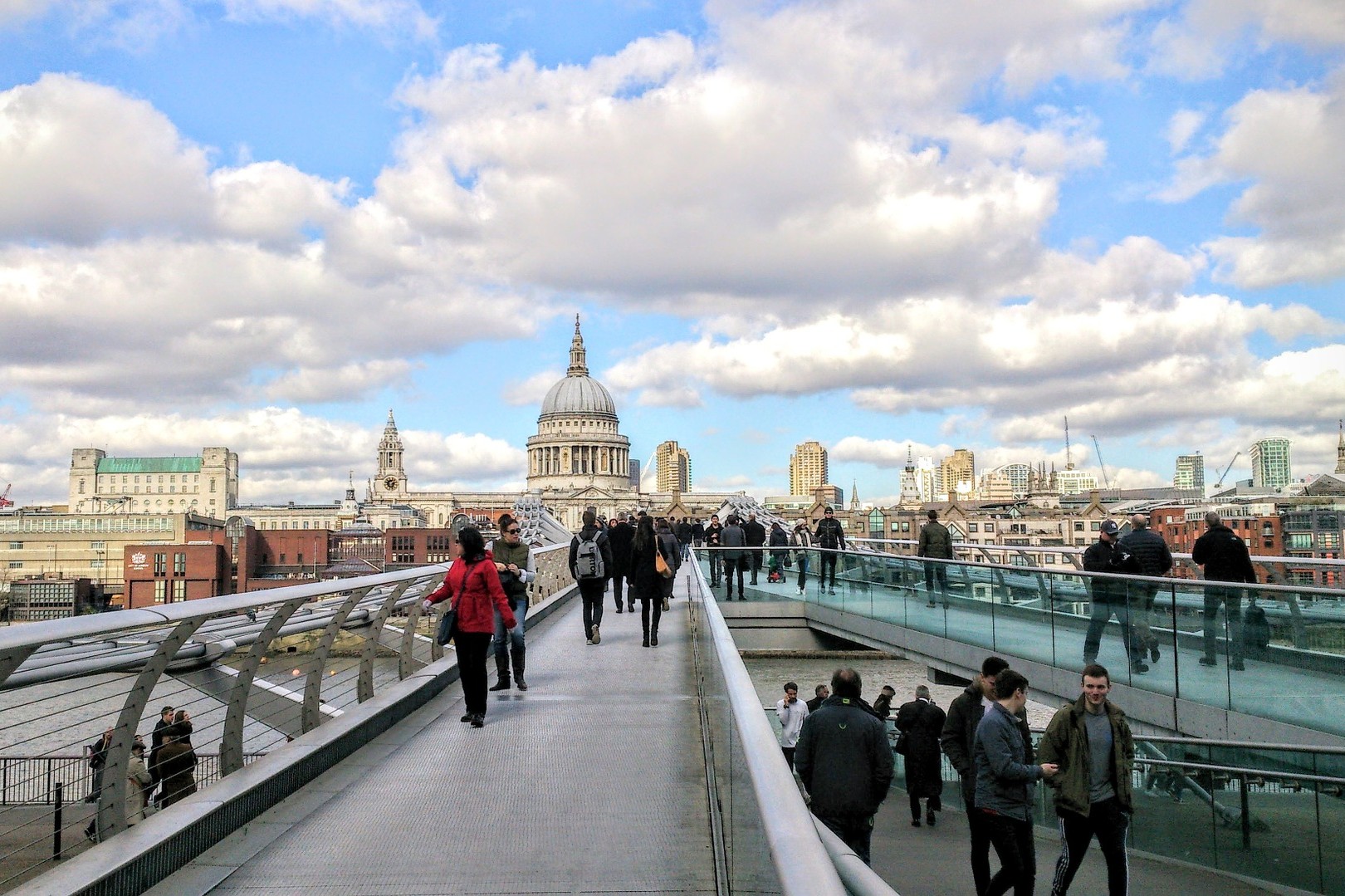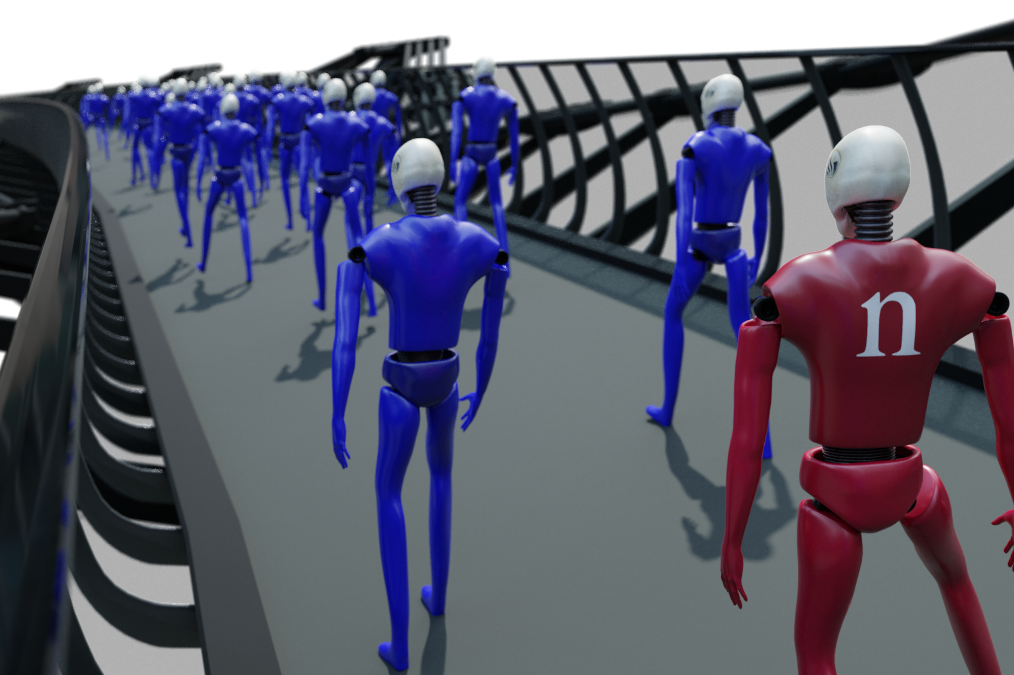
The Millennium Bridge

Each pedestrian added to the bridge provides negative damping on average, without synchronising their footsteps to all the others. Thus, in theory, there is a critical number of pedestrians n, such that the nth pedestrian is like the straw that breaks the camel's back, so that there is a critical amount of negative damping for the bridge oscillations to start to grow. Kevin Daley, Georgia State University
An international team of engineers and mathematicians, led by Georgia State University in the United States and the University of Bristol, has dispelled previous theories around why London's Millennium Bridge moves from side-to-side when being crossed by large numbers of pedestrians.
One of the most important mathematical and physical theories of the last 20 years has been spontaneous emergence of synchronous behaviour from incoherent agents.
Examples include the co-ordinated flashing of fireflies or the sudden onset of synchronous clapping after a speech.
In popular explanations of this (for example in the 2019 Royal Institution Christmas Lectures) probably the most commonly used example is that of the pedestrian-induced instability on the opening day of the London Millennium Bridge.
Supposedly, once the bridge became filled with sufficiently many people, they spontaneously and involuntarily started to co-ordinate their behaviour; the frequency at which they made their footsteps became 'locked-in' to the natural frequency of the bridge (the frequency at which the bridge 'wants' to oscillate). The result was scary sideways swaying of the bridge.
This was thought to be a brand-new phenomenon, and a complete surprise to bridge designers who had previous believed that such large bridge oscillations would only occur if soldiers were to march in step, and that uncoordinated pedestrians were not a worry.
The popular myth is that in effect 'naive engineers' were put in their place by 'clever physicists and mathematicians'.
In fact, there is a simpler explanation hiding in plain sight in engineering analysis and publications - the bridge goes unstable simply by pedestrians trying not to fall over.
In this new research published in the Journal Nature Communications, the team finally dispel this 'synchronisation myth'. They found that many other bridges have exhibited large amplitude lateral oscillations when carrying large crowds of people and there is little or no evidence of footstep synchronisation.
The only explanation that is consistent with all evidence is that in trying not to fall over, the pedestrians walking randomly provide 'negative damping' – a positive feedback effect where energy is transferred from pedestrian wobbling into bridge motion. In fact, the bridge engineers who fixed the problem were right all along.
Any synchronisation observed is typically a consequence, rather than a cause, of the bridge motion.
The team arrived at this conclusion through a careful review of all available observational and experimental evidence, new rigorous mathematical analysis, and detailed computer simulation, harnessing the combined expertise of a unique interdisciplinary, multi-national team.
The findings are important for bridge engineers because large oscillations can occur for a wide range of bridge frequencies, so trying to avoid the problem by ensuring that the bridge frequency is not close to typical pedestrian pacing frequencies is potentially dangerous.
More generally, for a wide range of systems in nature and society, the paper argues that this macro-scale instability (in this case the bridge motion) may emerge from micro-scale behaviour (in this case of many individual pedestrians) without there being any obvious causal synchrony. It also points to other examples in economic cycles and the tuning of remarkably sensitive hearing organs in mammals and insects.
Professor Alan Champneys from the University of Bristol's Department of Engineering Mathematics, said: "This international, multi-University collaboration has been a long story, but shows the unique power of interdisciplinary collaboration between practical engineers, mathematicians and physicists.
"Sometimes the answer is hiding in plain sight, but the wisdom of the crowd has led for many years to an incorrect explanation of what is a very simple idea."
Professor Igor Belykh from Georgia State University, added: "I have long been fascinated by the mathematical theory of synchronisation, and attempted to apply the theory to bridge instability, but it was only after interaction with colleagues at the University of Bristol, that I realised there was a different story, which has been tremendous fun to finally understand together even if, because of the global pandemic, most of our work has been carried out over Zoom."
Professor John Macdonald from Bristol's Department of Civil Engineering, said: "It wasn't the form of the London Millennium Bridge that caused the problem. These large oscillations can occur on virtually any long bridge when carrying a sufficiently large crowd.
"It turns out that the forces from many random left and right footsteps do not cancel out, but positive feedback leads to the vibrations getting out of hand, a bit like when two or more laptops are too close to each other on a Zoom call, which is ironic because most of this work was conducted over Zoom with our collaborators in Cambridge, Atlanta and Wroklaw."
Following this research the team hope to further investigate the biomechanics of the mechanism in more detail at the individual level and to consider the crowd behaviour, including interactions between pedestrians in the crowd. They also want to address vertical human-induced vibrations of structures in a similar way.
These investigations will require further mathematical modelling and experiments, both in the laboratory and on real bridges. The aim will be to quantify the effect in a wide range of conditions, leading to safer, yet efficient, guidance for bridge design.






